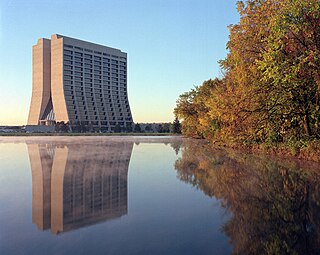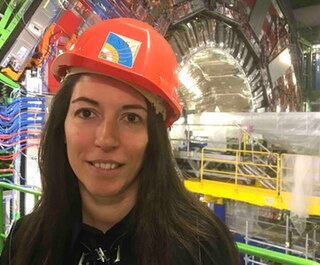
Leon Max Lederman was an American experimental physicist who received the Nobel Prize in Physics in 1988, along with Melvin Schwartz and Jack Steinberger, for research on neutrinos. He also received the Wolf Prize in Physics in 1982, along with Martin Lewis Perl, for research on quarks and leptons. Lederman was director emeritus of Fermi National Accelerator Laboratory (Fermilab) in Batavia, Illinois. He founded the Illinois Mathematics and Science Academy, in Aurora, Illinois in 1986, where he was resident scholar emeritus from 2012 until his death in 2018.

Particle physics or high-energy physics is the study of fundamental particles and forces that constitute matter and radiation. The field also studies combinations of elementary particles up to the scale of protons and neutrons, while the study of combination of protons and neutrons is called nuclear physics.

The Tevatron was a circular particle accelerator in the United States, at the Fermi National Accelerator Laboratory, east of Batavia, Illinois, and was the highest energy particle collider until the Large Hadron Collider (LHC) of the European Organization for Nuclear Research (CERN) was built near Geneva, Switzerland. The Tevatron was a synchrotron that accelerated protons and antiprotons in a 6.28 km (3.90 mi) circumference ring to energies of up to 1 TeV, hence its name. The Tevatron was completed in 1983 at a cost of $120 million and significant upgrade investments were made during its active years of 1983–2011.

The top quark, sometimes also referred to as the truth quark, is the most massive of all observed elementary particles. It derives its mass from its coupling to the Higgs field. This coupling yt is very close to unity; in the Standard Model of particle physics, it is the largest (strongest) coupling at the scale of the weak interactions and above. The top quark was discovered in 1995 by the CDF and DØ experiments at Fermilab.
The bottom quark, beauty quark, or b quark, is an elementary particle of the third generation. It is a heavy quark with a charge of −1/3 e.

The Large Hadron Collider (LHC) is the world's largest and highest-energy particle accelerator. It was built by the European Organization for Nuclear Research (CERN) between 1998 and 2008 in collaboration with over 10,000 scientists and hundreds of universities and laboratories across more than 100 countries. It lies in a tunnel 27 kilometres (17 mi) in circumference and as deep as 175 metres (574 ft) beneath the France–Switzerland border near Geneva.

The Collider Detector at Fermilab (CDF) experimental collaboration studies high energy particle collisions from the Tevatron, the world's former highest-energy particle accelerator. The goal is to discover the identity and properties of the particles that make up the universe and to understand the forces and interactions between those particles.

The DØ experiment was a worldwide collaboration of scientists conducting research on the fundamental nature of matter. DØ was one of two major experiments located at the Tevatron Collider at Fermilab in Batavia, Illinois. The Tevatron was the world's highest-energy accelerator from 1983 until 2009, when its energy was surpassed by the Large Hadron Collider. The DØ experiment stopped taking data in 2011, when the Tevatron shut down, but data analysis is still ongoing. The DØ detector is preserved in Fermilab's DØ Assembly Building as part of a historical exhibit for public tours.

Chris Quigg is an American theoretical physicist at the Fermi National Accelerator Laboratory (Fermilab). He graduated from Yale University in 1966 and received his Ph.D. in 1970 under the tutelage of J. D. Jackson at the University of California, Berkeley. He has been an associate professor at the Institute for Theoretical Physics, State University of New York, Stony Brook, and was head of the Theoretical Physics Department at Fermilab from 1977 to 1987.

Joseph David Lykken is an American theoretical physicist at the Fermi National Accelerator Laboratory and, from July 1, 2014 to Sept 6, 2022, he was the Deputy Director of Fermilab. He is currently Director of Fermilab's Quantum Division.
Arie Bodek is an American experimental particle physicist and the George E. Pake Professor of Physics at the University of Rochester.
Joseph Incandela is an American particle physicist, a professor of physics at the University of California, Santa Barbara and currently based at CERN, where he spent two years as the spokesperson for the Compact Muon Solenoid experiment at the Large Hadron Collider.

Sir Tejinder Singh Virdee,, is a Kenyan-born British experimental particle physicist and Professor of Physics at Imperial College London. He is best known for originating the concept of the Compact Muon Solenoid (CMS) with a few other colleagues and has been referred to as one of the 'founding fathers' of the project. CMS is a world-wide collaboration which started in 1991 and now has over 3500 participants from 50 countries.
Paraskevas Andreas Sphicas is a particle physicist who focuses on studies of High energy collisions in the Large Hadron Collider through which he explores supersymmetry and the mechanism of spontaneous symmetry breaking. He is a senior scientist at CERN and professor of physics at the National and Kapodistrian University of Athens. He was elected a Fellow of the Royal Society (FRS) in 2019.
Tulika Bose is a professor of physics at the University of Wisconsin-Madison, whose research focuses on developing triggers for experimental searches of new phenomena in high energy physics. Bose is a leader within the Compact Muon Solenoid (CMS) experiment, a CERN collaboration famous for its experimental observation of the Higgs boson in 2012.

Bradley Cox is an American physicist, academic and researcher. He is a Professor of Physics and the founder of the High Energy Physics Group at the University of Virginia.

Meenakshi Narain was an Indian-born American experimental physicist. She was a Professor of Physics and Chair of the Department of Physics at Brown University, and was also Chair of the Collaboration Board of U.S. institutions in the Compact Muon Solenoid (CMS) Collaboration. She contributed to the discovery of the top quark in 1995 and Higgs Boson in 2012.

Florencia Canelli is since 2021 the appointed Swiss scientific delegate to the CERN council, the supreme decision-making authority of the CERN Organization. From 2021-2024, she was appointed chair of the IUPAP division of particles and field (C11). From 2021-2023, she was co-coordinator of the physics program of the CMS collaboration, a CERN experiment with over 3000 physicists. In 2010, Canelli was awarded the IUPAP Young scientist prize, an international prize awarded to one experimental and one theoretical physicist per year, for "her pioneering contribution to the identification and precision measurements of rare phenomenon through the use of advanced analysis techniques to separate very small signals from large background processes at the Tevatron collider." She has been an author on four multi-purpose collider experiments, namely the CMS experiment and ATLAS experiment at the CERN LHC, and the CDF experiment and D0 experiment at the Fermilab Tevatron. She is currently a full professor at the University of Zurich, Physics Institute, specializing in particle physics.
Freya Blekman is a Dutch professor at the University of Hamburg and the lead scientist at Deutsches Elektronen-Synchrotron (DESY). She contributed to the discovery of the Higgs boson at CERN and has been endowed the Helmholtz Distinguished Professorship. Her individual work specializes in the physics and experimental aspects of elementary particles and fields, specifically looking at the top quark sector by using precision measurements.
Christopher Scott Hill is an American particle physicist and Professor of Physics at The Ohio State University. He is known for his contributions to the study of the top quark and for co-founding the milliQan Experiment at the Large Hadron Collider.













